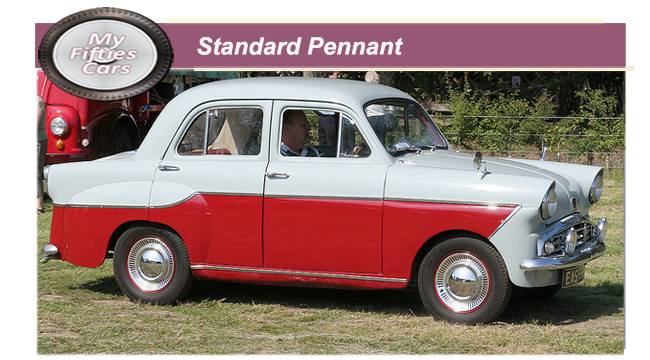
In the 1950s, Standard knew almost as much as the Rootes Group about badge engineering and facelifts. In October 1957, just four years after the Eight/Ten family had been launched, the Pennant was introduced, this being, effectively, a better-equipped and more garishly styled version of the Ten.
Standard's own stylists added a new hooded-headlamp, full-width-grille nose
A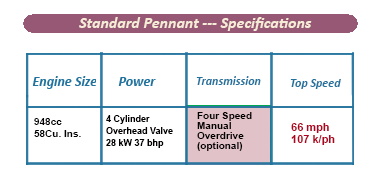 lmost forgotten now, the Standard Pennant was an upmarket version Of the Standard Ten , in turn a development of the Standard Eight.
lmost forgotten now, the Standard Pennant was an upmarket version Of the Standard Ten , in turn a development of the Standard Eight.
The Ten was launched in 1954 in response to feedback that the Eight was just too basic and limited and deterring customers.
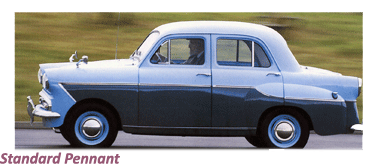 By offering what was basically a De Luxe version as the Ten, Standard’’s thinking apparently was the original, sparsely equipped model could remain in production and be marketed as a separate model for the budget conscious.
By offering what was basically a De Luxe version as the Ten, Standard’’s thinking apparently was the original, sparsely equipped model could remain in production and be marketed as a separate model for the budget conscious.
 The thinking proved to be off themark as, although the Ten was slightly more upmarket, it still didn't go far enough to be an attractive purchase, so Standard needed yet another model and another name — the Pennant.
The thinking proved to be off themark as, although the Ten was slightly more upmarket, it still didn't go far enough to be an attractive purchase, so Standard needed yet another model and another name — the Pennant.
![]()
The new car featured a more powerful 28kW (37bhp) version of the 948cc (58 cu in) engine, two-tone paintwork, hooded headlights and longer front and rear wings.
 A larger rear window and a more flamboyant, three-bar grille were also part of the package and extra chrome strips along the car's flanks made sure your neighbours knew your car wasn't a mere Eight or Ten.
A larger rear window and a more flamboyant, three-bar grille were also part of the package and extra chrome strips along the car's flanks made sure your neighbours knew your car wasn't a mere Eight or Ten.
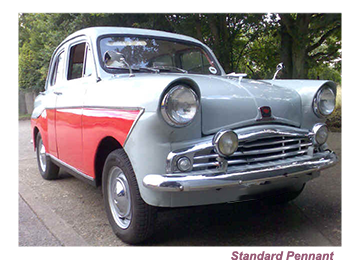 Despite the hype, the Pennant was not much more than a badge-engineered Standard Ten, which also featured a little more equipment and rear tail fins to the basic Ten four-door shell. Inside the car was a new fascia style, along with a remote control centre-floor gear change.
Despite the hype, the Pennant was not much more than a badge-engineered Standard Ten, which also featured a little more equipment and rear tail fins to the basic Ten four-door shell. Inside the car was a new fascia style, along with a remote control centre-floor gear change.
 Power was pushed up to 37bhp, and overdrive was an optional extra (popular) as was the two-pedal control "Standrive" (a commercial flop). Two-tone upholstery and duotone paintwork were both standard.
Power was pushed up to 37bhp, and overdrive was an optional extra (popular) as was the two-pedal control "Standrive" (a commercial flop). Two-tone upholstery and duotone paintwork were both standard.
As the Fifties progressed, the Standard/ Triumph Group were becoming as proficient as their rivals at the Rootes Group- especially on the practice of badge engineering and facelifts.
![]()
A larger rear window and a more flamboyant, three-bar grille were also part of the package, and extra chrome strips along the car's flanks were added to ensure that people in the neighbourhood or colleagues at work knew your car wasn't a mere Eight or Ten.
D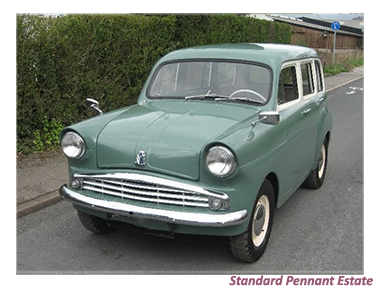 espite being far from inexpensive, the Pennant sold quite briskly for the two years that it was in production before being displaced by the Triumph Herald.
espite being far from inexpensive, the Pennant sold quite briskly for the two years that it was in production before being displaced by the Triumph Herald.
 Like the Eights and Tens, these cars were no high performers, although twin-carburettor tuning kits could turn them into brisk machines,
Like the Eights and Tens, these cars were no high performers, although twin-carburettor tuning kits could turn them into brisk machines,
This was evidenced when Pennants took second and third places in the 1958 RAC rally, a worthy performance by anyone’s Standards.


